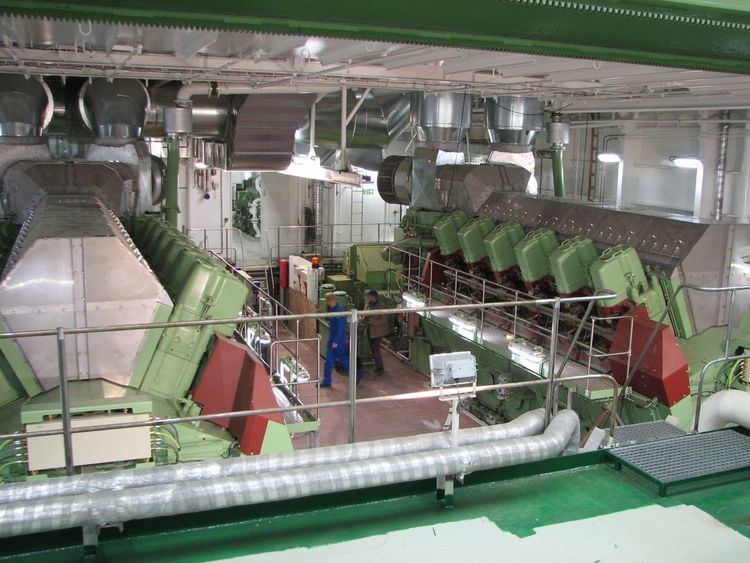 | ||
Marine propulsion is the mechanism or system used to generate thrust to move a ship or boat across water. While paddles and sails are still used on some smaller boats, most modern ships are propelled by mechanical systems consisting of an electric motor or engine turning a propeller, or less frequently, in pump-jets, an impeller. Marine engineering is the discipline concerned with the engineering design process of marine propulsion systems.
Contents
Marine steam engines were the first mechanical engines used in marine propulsion, however they have mostly been replaced by two-stroke or four-stroke diesel engines, outboard motors, and gas turbine engines on faster ships. Nuclear reactors producing steam are used to propel warships and icebreakers. Nuclear reactors to power commercial vessels has not been adopted by the marine industry. Electric motors using electric battery storage have been used for propulsion on submarines and electric boats and have been proposed for energy-efficient propulsion. Development in liquefied natural gas (LNG) fueled engines are gaining recognition for their low emissions and cost advantages. Stirling engines, which are more efficient, quieter, smoother running producing less harmful emissions than diesel engines, propel a number of small submarines. The Stirling engine has yet to be upscaled for larger surface ships.
Screws
Marine propellers are also known as "screws". There are many variations of marine screw systems, including twin, contra-rotating, controllable-pitch, and nozzle-style screws. While smaller vessels tend to have a single screw, even very large ships such as tankers, container ships and bulk carriers may have single screws for reasons of fuel efficiency. Other vessels may have twin, triple or quadruple screws. Power is transmitted from the engine to the screw by way of a propeller shaft, which may or may not be connected to a gearbox.
Paddle wheels
The paddle wheel is a large wheel, generally built of a steel framework, upon the outer edge of which are fitted numerous paddle blades (called floats or buckets). The bottom quarter or so of the wheel travels underwater. Rotation of the paddle wheel produces thrust, forward or backward as required. More advanced paddle wheel designs have featured feathering methods that keep each paddle blade oriented closer to vertical while it is in the water; this increases efficiency. The upper part of a paddle wheel is normally enclosed in a paddlebox to minimise splashing.
Paddle wheels have been superseded by screws, which are a much more efficient form of propulsion. Nevertheless, paddle wheels have two advantages over screws, making them suitable for vessels in shallow rivers and constrained waters: first, they are less likely to be clogged by obstacles and debris; and secondly, when contra-rotating, they allow the vessel to spin around its own vertical axis. Some vessels had a single screw in addition to two paddle wheels, to gain the advantages of both types of propulsion.
Sailing
The purpose of sails is to use wind energy to propel the vessel, sled, board, vehicle or rotor.
Water caterpillar
An early uncommon means of boat propulsion was the water caterpillar. This moved a series of paddles on chains along the bottom of the boat to propel it over the water and preceded the development of tracked vehicles. The first water caterpillar was developed by Desblancs in 1782 and propelled by a steam engine. In the United States the first water caterpillar was patented in 1839 by William Leavenworth of New York.
Buoyancy
Underwater gliders convert buoyancy to thrust, using wings, or more recently hull shape (SeaExplorer Glider). Buoyancy is made alternatively negative and positive, generating tooth-saw profiles.
